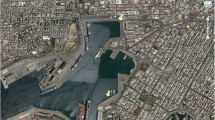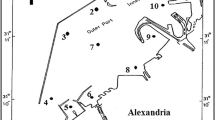Abstract
To evaluate the environmental impact of polluted sediments, several operationally defined sequential extraction procedures (SEPs) have been described. Salinity has long been recognised as an important variable determining the physicochemical behaviour of heavy metals in marine sediments. Thus, in the present paper, the modified BCR-SEP has been applied to harbour sediments in order to assess to what extent trace metal mobility (Cd, Cr, Cu, Ni, Pb and Zn) could be influenced by chloride content in sediments. For this, washed (W) and non-washed (NW) sediments were compared. The relative mobility order observed for the six trace metals studied was not seen to be influenced by the presence of chloride in the sediments, but an increase of mobility was observed for Cd and Zn (the most mobile metals) when chloride was present in the sediments. Characterisation of the sediments and of the pseudo-total metal contents by means of an aqua regia extraction was also assessed.



Similar content being viewed by others
References
Recomendaciones para la gestión del material de dragado en los puertos españoles (RRGMD) (1994) Centro de estudios y experimentación de Obras Públicas, Transportes y Medio Ambiente (CEDEX), Madrid
Mulligan CN, Yong RN, Gibbs BF (2001) J Hazard Mater 85:145–163
Seidel H, Löser C, Zehnsdorf A, Hoffmann P, Schmerold R (2004) Environ Sci Technol 38:1582–1588
Chapman P, Wang F (2001) Environ Toxicol Chem 20(1):3–22
Liang Y, Wong MH (2003) Chemosphere 52:1647–1658
Riba I, García-Luque E, Blasco J, DelValls TA (2003) Chem Spec Bioavailab 15(4):101–114
Gleyzes C, Tellier S, Astruc M (2002) TRAC-Trends Anal Chem 21(6–7):451–467
Sahuquillo A, López-Sánchez JF, Rauret G, Ure AM, Muntau H, Quevauviller Ph (2002) Methodologies for soil and sediment fractionation studies, Chap 2. The Royal Society of Chemistry, Cambridge
Rauret G, López-Sánchez JF, Sahuquillo A, Muntau H, Quevauviller Ph (2000) Indicative values for extractable contents (mass fractions) of Cd, Cr, Cu, Ni, Pb and Zn in sediment (CRM 601) following the modified BCR-sequential extraction (three-step) procedure. BCR Information Reference Materials Report EUR-report 17554 EN
Métodos Oficiales de Análisis (1994) Madrid, Tomo III:223–225, 239–240
Métodos Oficiales de Análisis (1994) Madrid, Tomo III:238–239, 263–265
International Standards Organisation (1995) Soil quality, extraction of trace elements soluble in aqua regia. ISO 11466, Geneva
Rauret G, López-Sánchez JF, Sahuquillo A, Rubio R, Davidson C, Ure A, Quevauviller Ph (1999) J Environ Monit 1:57–61
Sahuquillo A, López-Sánchez JF, Rubio R, Rauret G, Thomas RP, Davidson CM, Ure AM (1999) Anal Chim Acta 382:317–327
Guevara-Riba A, Sahuquillo A, Rubio R, Rauret G (2004) Sci Total Environ 321:241–255
Emmerson RHC, Birkett JW, Scrimshaw, Lester JN (2000) Sci Total Environ 254:75–92
Keckritz T, Thöming J, Gleyzes C, Ø degard KE (2001) Acta Hydroch Hydrob 29(4):197–205
Riba I, DelValls TA, Forja JM, Gómez-Parra A (2004) Environ Toxicol Chem 23(5):1100–1107
Ouddane B, Fischer JC, Wartel M (1992) Oceanol Acta 15:347–354
Molvaer J, Knutzen J, Magnusson J, Rygg B, Skei J, Sørensen J (2002) Norwegian marine environmental quality criteria—development and practice. Draft kindly supplied by the authors
Acknowledgements
The authors thank the DGICYT under project BQU2003-02951 for the financial help received in support of this study. A. Guevara-Riba thanks the Universitat de Barcelona for a PhD training Grant in Research and Teaching and A. Sahuquillo thanks MCYT for financial support. The authors would also like to express their gratitude to the Environmental Department of Barcelona Harbour Authority for the facilities used in the sampling of harbour sediments.
Author information
Authors and Affiliations
Corresponding author
Rights and permissions
About this article
Cite this article
Guevara-Riba, A., Sahuquillo, A., Rubio, R. et al. Effect of chloride on heavy metal mobility of harbour sediments. Anal Bioanal Chem 382, 353–359 (2005). https://doi.org/10.1007/s00216-005-3103-x
Received:
Revised:
Accepted:
Published:
Issue Date:
DOI: https://doi.org/10.1007/s00216-005-3103-x




